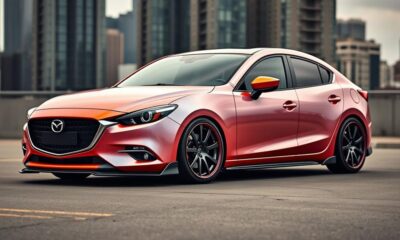Jeep Tuning
Jeep 258 Weber Carb Tuning: Maximizing the Power of Your Classic Jeep Engine
Find out how to optimize your Jeep 258’s Weber carburetor for maximum performance and efficiency, and uncover secrets that could transform your driving experience.

Tuning the Weber carburetor on your Jeep 258 engine can greatly boost its power and efficiency. Start by adjusting the mixture screw about two turns out for ideal fuel flow. Make sure to set the idle speed to 600-800 RPM for a smooth operation. Don't forget to check and tune the timing, aiming for around 12 degrees advanced. It's also essential to inspect for vacuum leaks, as they can undermine performance. Finally, document your adjustments to track progress and troubleshoot issues effectively. Stick around to discover more tips to get the most out of your classic Jeep engine.
Key Takeaways
- Start by setting the mixture screw two full turns out to establish a baseline for tuning the Weber carburetor.
- Ensure the initial timing is set at 12 degrees after disconnecting the vacuum advance hose for optimal engine performance.
- Adjust the idle speed to maintain a stable RPM between 600-800, preventing stalling during operation.
- Calibrate the choke properly, ensuring it operates effectively for easy cold starts and smooth performance under varying temperatures.
- Regularly check for vacuum leaks and ensure all connections are secure to maintain optimal engine efficiency and responsiveness.
Weber Carburetor Basics
Understanding the Weber carburetor basics is important for optimizing your Jeep 258's performance. The Weber 32/36 carburetor features a progressive two-barrel design, which enhances fuel efficiency and power across various driving conditions. This setup is particularly beneficial for your Jeep's I6 engine.
One of the standout features is the electronic choke, which provides better cold start performance compared to traditional systems.
To guarantee your Weber carburetor operates at its best, proper tuning is essential. Start by adjusting the mixture screw, typically set two full turns out from the bottom. Next, fine-tune the speed screw, which should be adjusted out 1 to 1.5 turns for a smooth idle.
While the engine is running, keep an eye out for symptoms like blackish unburnt fuel, as this often signals a need for further tuning adjustments.
Regular maintenance and routine checks of your tuning settings are crucial in maximizing the performance and longevity of the Weber carburetor. By understanding these basics, you'll be well-equipped to keep your Jeep 258 running smoothly and efficiently.
Installation and Initial Setup

When you start the installation of the Weber carburetor on your Jeep 258, make certain to properly mount it with grease on the plates for a secure fit.
After that, you'll want to set the idle speed and calibrate the choke to guarantee your engine runs smoothly in various conditions.
Following these steps will lay the groundwork for peak performance.
Carburetor Mounting Process
Properly mounting the Weber 32/36 carburetor on your Jeep 258 I6 engine is fundamental for peak performance. Start by ensuring the carburetor is aligned correctly with the engine. To facilitate a good seal during installation, apply grease to the mounting plates. Use hex head screws; they make adjustments easier and allow you to secure them tightly. Consider applying Loctite to prevent loosening caused by engine vibrations.
Next, pay close attention to the positioning of the fuel filter. It should be placed correctly relative to the Weber float bowl to avoid fuel delivery issues.
Once everything is in place, disconnect the vacuum advance hose during timing adjustments. This is critical for accurately setting the initial timing at 12 degrees, which is essential for ideal carburetor function.
After the carburetor mounting process is complete, monitor your engine. Watch for any idling issues or stalling, as these can indicate improper tuning.
You may need to adjust the air-fuel mixture and idle speed settings to achieve the best performance from your newly mounted carburetor.
Setting Idle Speed
After mounting the Weber carburetor, setting the idle speed is your next step for peak performance. Follow these steps to guarantee a smooth and stable idle:
- Adjust the Speed Screw: Turn the speed screw out 1 to 1.5 turns from the fully closed position as a baseline.
- Warm Up the Engine: Make certain the engine is warm before proceeding to fine-tune any settings.
- Disconnect the Vacuum Advance: This prevents interference with timing and helps maintain idle stability during adjustments.
- Monitor Idle RPM: Fine-tune the speed screw until you achieve a stable idle around 600-800 RPM. If you notice the engine stalling, gradually increase the idle speed until it runs consistently.
Document your idle speed adjustment settings for future reference, and keep track of any changes made during subsequent tuning sessions.
Properly setting idle speed not only enhances performance but also guarantees that your Jeep runs smoothly.
With these steps, you're well on your way to maximizing the power of your classic Jeep engine!
Choke Calibration Steps
Calibrating the choke is essential for guaranteeing your Jeep starts easily and runs smoothly in cold conditions.
Begin by cooling the choke coil to below 20°C (68°F) using an ice bag. This step is critical for accurate choke calibration, as it allows the mechanism to respond correctly during adjustments.
Next, check the choke lever to confirm that the butterfly valve operates properly. This verifies the air-fuel mixture is ideal during startup.
Once you've verified this, set the fast idle cam to the appropriate position. This adjustment is pivotal for maintaining the correct idle speed when the engine is cold, making those chilly morning starts easier.
After adjusting, document all your choke settings and modifications with a paint pen. This record will be invaluable for future tuning and maintenance, as it helps you maintain consistent performance.
Adjusting Engine Timing

To get the best performance from your Jeep 258, you need to set the initial timing to about 12 degrees advanced.
Don't forget to disconnect the vacuum advance hose while making adjustments, as this can affect your results.
Using a timing gun and a wrench will help you fine-tune everything for ideal engine operation.
Optimal Timing Settings
Achieving ideal timing settings is essential for maximizing the performance of your Jeep 258 engine. When you fine-tune your timing, you're reviving an old thread of power and efficiency that your classic engine deserves. Here's how to get started:
- Set Initial Timing: Adjust your timing to approximately 12 degrees advanced. This helps enhance performance and guarantees proper combustion.
- Disconnect Vacuum Advance: Before making adjustments, disconnect and plug the vacuum advance hose to avoid interference with your timing readings.
- Use a Timing Gun: Grab a timing gun to accurately check and adjust the timing. Remember to loosen the distributor bolt for fine-tuning.
- Recheck Timing: Regularly recheck your timing settings. Engine vibrations can shift timing, affecting your overall performance and idling stability.
After you've made your initial adjustments, reconnect the vacuum advance hose.
For further tuning, use a vacuum gauge to improve engine efficiency. By following these steps for enhanced timing settings, you'll guarantee your Jeep 258 runs smoothly and powerfully.
Vacuum Advance Importance
The vacuum advance mechanism plays a significant role in enhancing engine timing for your Jeep 258. By adjusting the engine timing to 12 degrees advanced while disconnecting the vacuum advance hose, you can greatly improve performance. This adjustment enhances engine responsiveness and fuel efficiency, ultimately boosting power delivery.
Using a timing gun for precise adjustments is essential. It guarantees consistent timing, which is necessary for effective combustion and helps prevent backfiring issues. Disconnecting the vacuum advance during these adjustments prevents erroneous readings, leading to a more accurate setting that stabilizes engine idle and improves throttle response.
Additionally, regularly checking and adjusting the vacuum lines is important. Preventing leaks guarantees the vacuum advance operates effectively, which directly impacts engine timing and overall performance.
Here's a quick reference table to help you understand these concepts:
| Action | Benefit | Importance |
|---|---|---|
| Adjust engine timing | Enhances responsiveness | Guarantees optimal combustion |
| Use a timing gun | Maintains consistent timing | Reduces backfiring risk |
| Check vacuum lines | Prevents leaks | Stabilizes engine performance |
Timing Adjustment Techniques
Adjusting engine timing is a straightforward process that can greatly improve your Jeep 258's performance, complementing the enhancements gained from correctly setting the vacuum advance.
By following these timing adjustment techniques, you'll guarantee your engine runs smoothly and efficiently.
- Set Initial Timing: Start with your timing set to approximately 12 degrees advanced. Make certain to disconnect and plug the vacuum advance hose during this step.
- Use a Timing Gun: This tool allows you to measure the timing accurately. You'll need to loosen the distributor bolt with a 1/2 box wrench to make necessary adjustments.
- Reconnect Vacuum Advance: After your initial adjustments, reconnect the vacuum advance hose. This is essential for optimum performance.
- Check for Vacuum Leaks: Regularly inspect all vacuum hoses to confirm they're connected properly and free of leaks, as these can greatly impact timing and overall engine operation.
Remember to check and recheck your timing settings, as improper engine timing can lead to poor carburetor function and performance issues.
Troubleshooting Vacuum Leaks
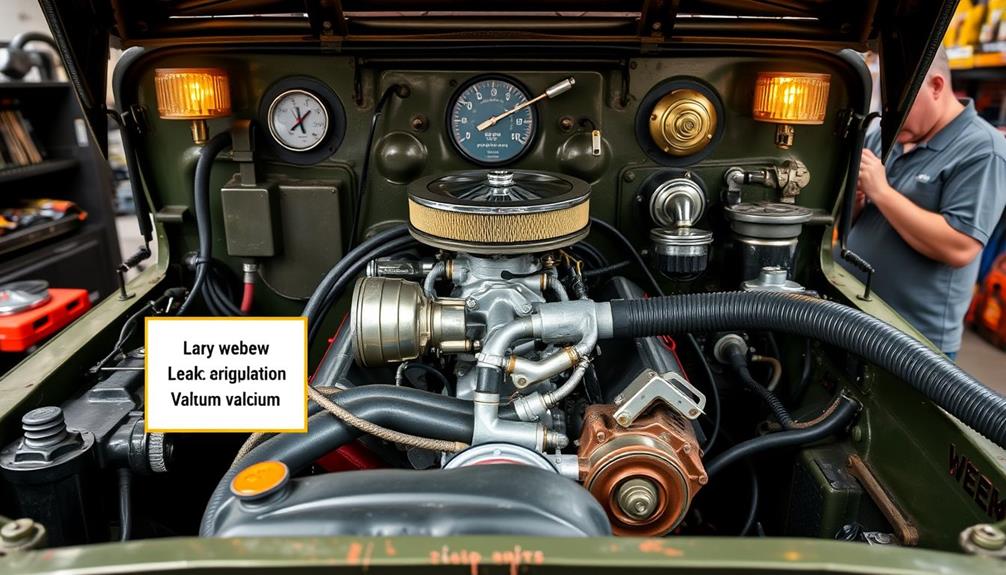
When it comes to troubleshooting vacuum leaks, you'll want to start by thoroughly inspecting all vacuum hoses and connections. Look for cracks, tears, or loose fittings, as improper connections can lead to poor carb performance and stalling issues.
Next, pay attention to crimped-off ports on the intake manifold; these often cause significant vacuum leaks that disrupt the air-fuel mixture.
Confirm the intake manifold is properly matched to your engine model. Mismatched components can exacerbate vacuum leak problems, making it essential to double-check compatibility.
Additionally, loose bolts on adapter plates can contribute to vacuum leaks due to engine vibrations, so regularly check and secure these bolts.
As you adjust the mixture screws, monitor their performance closely. If you find that they don't seem to affect the engine's performance, this is a strong indicator of potential vacuum leaks in the system.
Addressing these leaks not only improves your Jeep's performance but also enhances fuel efficiency. By following these steps, you'll guarantee that your Weber carb operates at its best, maximizing the power of your classic Jeep engine.
Optimizing Electric Choke

After you've tackled vacuum leaks, focusing on the electric choke is vital for enhancing your Weber carb's performance. A well-calibrated electric choke not only aids in cold starts but also guarantees smooth operation as your engine warms up.
Here's how to get it right:
- Check the Power Source: Verify the electric choke is powered by the pressure switch on the engine block during cranking.
- Monitor Engine Temperature: The manifold heater relay coil should power the choke heater until your engine reaches 160°F, keeping the choke plates open for peak performance.
- Proper Calibration: Adjust the choke coil when its temperature is below 68°F (20°C) for effective settings. This is essential for smooth startups.
- Document Adjustments: After tuning, use a paint pen to mark your choke settings. This will help with future tuning and troubleshooting.
With these steps, you can achieve the proper calibration of your electric choke, directly impacting the air-fuel mixture during startup. This results in improved performance and reliability for your classic Jeep engine.
Tuning Mixture and Speed
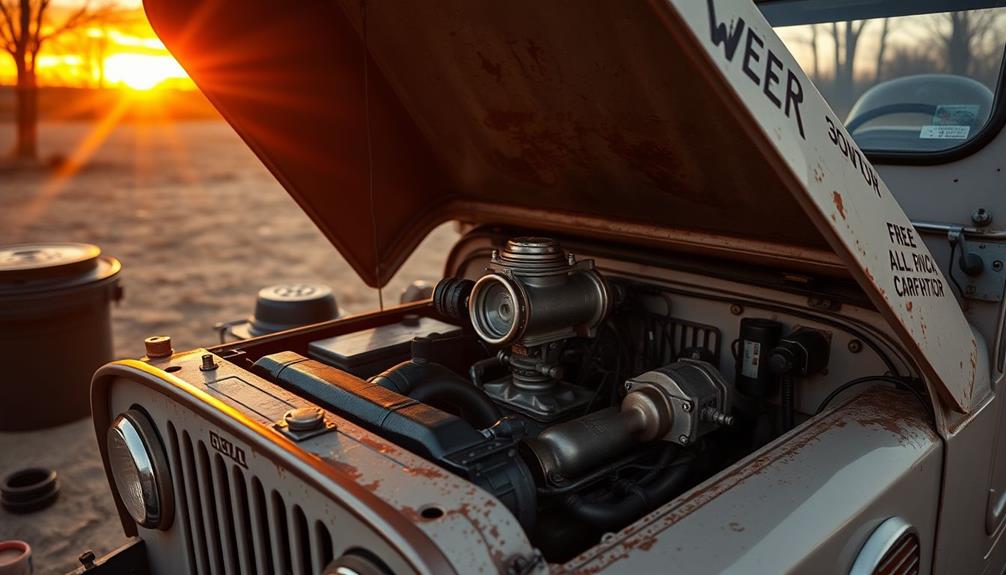
Achieving the perfect balance in your Jeep's air-fuel mixture and idle speed is essential for ideal engine performance.
Start with the mixture screw on your Weber 32/36 carburetor. Turn it in until it bottoms out, then adjust it out two full turns to set a peak air-fuel mixture. This initial adjustment helps guarantee your engine runs smoothly and efficiently.
Next, focus on the speed screw. Adjust it out one to 1.5 turns from the fully in position to achieve the proper idle speed. Accurate tuning of both the mixture and speed screws is critical for a stable idle and maximizing your engine's power.
As you make these adjustments, remember to keep a record of each change. This documentation will be invaluable for future reference and troubleshooting any issues that may arise.
Be cautious not to over-tighten the screws during tuning; applying just enough pressure to secure them without causing damage is key to maintaining their integrity.
With careful adjustments to the mixture and speed screws, you can release your Jeep's full potential on the road or trail.
Common Carburetor Issues

Common issues with the Weber 32/36 carburetor on Jeep 258 engines can lead to frustrating performance problems. When you notice symptoms like idling problems, it's vital to diagnose the root cause quickly. Here are some common issues you might encounter:
- Engine Stalling: If your engine stalls shortly after starting, it often requires throttle assistance to stay running.
- Improper Air-Fuel Mixture: A blackish unburnt fuel residue in your carburetor indicates tuning issues that need immediate attention.
- Backfiring: If you experience backfiring through the carburetor, it's likely due to incorrect tuning or a vacuum leak, both of which must be addressed for peak performance.
- Vacuum Leaks: A malfunctioning brake booster connection can interfere with vacuum levels, adversely affecting carb performance.
To resolve these issues, you should thoroughly check all vacuum hoses and connections.
Adjusting the mixture screws won't help if underlying problems are present, so make sure everything is in order.
With proper attention to these common carburetor issues, you can restore your Jeep's performance and enjoy a smoother ride.
Performance Modifications

When you're looking to boost your Jeep 258's performance, considering upgrades to the carburetor is a smart move. The Weber 32/36 carburetor can greatly enhance throttle response and overall engine performance. Its superior air-fuel mixture delivery compared to stock carburetors guarantees your engine runs smoothly and efficiently.
To maximize the benefits of your performance modifications, fine-tune the idle speed and air-fuel mixture screws. Starting with 1-1.5 turns out from fully in will stabilize your engine and help prevent stalling issues.
Additionally, implementing an inline electric fuel pump guarantees consistent fuel delivery, which can mitigate the long crank times often associated with carbureted engines.
Don't overlook the importance of ignition timing; ideally, set it at 12 degrees with the vacuum advance disconnected, as this is vital for maximizing power and efficiency in your 258 engine.
While the Weber 32/36 is a solid choice, you might also consider alternative carburetors like the MC2100 or Carter BBD, which may offer enhanced performance and easier tuning.
With these modifications, you'll reveal your Jeep's true potential on and off the road.
Maintenance and Documentation

To keep your Weber carburetor running at its best, regular maintenance and thorough documentation are key.
By staying organized, you can guarantee smoother performance and quicker troubleshooting.
Here are four essential tips:
- Document Tuning Adjustments: Keep a detailed log of all mixture and speed screw settings. This reference will help you with future tuning efforts.
- Track Performance Changes: Note any variations in idling stability and throttle response after adjustments. Over time, you'll identify what works best for your setup.
- Record Calibration Conditions: When calibrating the choke, document the temperature and environmental conditions. This helps maintain consistent performance, regardless of changing weather.
- Log Parts and Modifications: Maintain records of any parts replaced or modifications to the fuel system. Understanding these changes can greatly impact your carburetor's performance.
Frequently Asked Questions
How Can I Increase the Power of My Jeep?
To increase your Jeep's power, upgrade components like the carburetor, guarantee proper tuning, and check ignition timing. Regularly inspect for vacuum leaks and maintain the engine to enhance performance and throttle response effectively.
How Do You Adjust the Air Fuel Mixture on a Weber Carburetor?
Adjusting your Weber carburetor's air-fuel mixture is like tuning a fine instrument. Start with the mixture screw gently bottomed out, then back it out two turns, and tune for peak performance while monitoring vacuum readings.
Conclusion
In your journey to juice up your Jeep 258, remember that meticulous tuning and timely tweaks can transform your classic engine into a powerhouse. By balancing the beauty of the Weber carb with thoughtful adjustments, you'll harness horsepower and enhance efficiency. Stay savvy about common conundrums and keep your carb in top condition. With consistent care and creative modifications, your Jeep's performance will surely soar, satisfying your thirst for adventure and acceleration on every trail.
Jimmy is a dedicated drift and drag racing enthusiast who deeply understands the unique tuning requirements for these high-octane sports. His expertise covers everything from drift suspension setups to drag racing launch control systems, providing our readers with the knowledge they need to compete at the highest levels. Jimmy’s passion for these motorsports shines through in his detailed articles and practical recommendations.
Jeep Tuning
Jeep Liberty 2012 Tuning: Bringing Modern Performance to Your Rugged SUV
Discover how tuning your 2012 Jeep Liberty can enhance performance and efficiency; learn the top upgrades to unleash its true potential.

Tuning your 2012 Jeep Liberty is a great way to enhance its performance and fuel efficiency while keeping that rugged appeal. You can easily boost horsepower with performance programmers like Superchips Flashpaq and Hypertech Max Energy, adding an impressive 10-20 HP. Consider upgrades like a cold air intake for improved airflow and an aftermarket exhaust system to enhance sound and efficiency. Installing throttle body spacers can further optimize your engine's performance. With these upgrades, you'll enjoy a more responsive driving experience. Curious about more ways to maximize your Liberty's potential? Stick around for some top tips and tricks!
Key Takeaways
- Upgrade the cold air intake to boost horsepower by 5-20 HP and enhance throttle response for improved driving dynamics.
- Install a free-flow exhaust system to reduce backpressure, enhancing engine performance and providing a more aggressive sound.
- Utilize performance programmers like Superchips Flashpaq to optimize ignition timing and fuel mixtures, potentially increasing horsepower by 10-20 HP.
- Add throttle body spacers and aftermarket headers to improve airflow, contributing to better acceleration and overall efficiency.
- Regularly tune and recalibrate your vehicle after modifications to ensure optimal performance and fuel efficiency during adventures.
Jeep Liberty Performance Overview
The 2012 Jeep Liberty delivers a solid blend of power and versatility thanks to its 3.7L V6 engine, which generates around 210 horsepower and 235 lb-ft of torque. This engine provides you with adequate power for both on-road and off-road adventures, making it a reliable choice for various driving conditions.
If you're looking to maximize its performance, consider using performance programmers like the Superchips Flashpaq or Hypertech Max Energy. These tools allow you to make tuning adjustments that can greatly enhance your vehicle's drivability and improve fuel efficiency.
Additionally, upgrading components such as throttle body spacers and aftermarket headers can help improve air intake and exhaust flow. This leads to increased throttle response and overall engine performance.
You might also want to explore other modifications like cold air intakes and free-flow exhaust systems, which can add an extra 10-20 horsepower when installed correctly.
The Jeep Liberty's off-road capabilities can be further optimized with suspension upgrades, ensuring you maintain a comfortable driving experience while tackling rugged terrains.
With the right performance enhancements, your Liberty can become an even more formidable SUV.
Benefits of Tuning Your SUV

Tuning your 2012 Jeep Liberty can greatly enhance your driving experience by optimizing engine performance and efficiency. By adjusting ignition timing and fuel mixture, you could see an increase of 10-20 HP in horsepower and torque. This boost not only makes your vehicle more powerful but also improves overall drivability, especially in off-road conditions.
Using performance programmers like Superchips Flashpaq allows you to make quick adjustments, leading to enhanced throttle response and smoother acceleration. These improvements make your Liberty more enjoyable on any terrain.
Additionally, tuning can help you achieve better fuel efficiency, potentially increasing your miles per gallon (MPG), which helps offset fuel costs during your adventures.
Moreover, tuning releases features like adjustable rev limits and speedometer calibration, accommodating modifications such as larger tires and different gear ratios. This level of customization guarantees your ride is tailored to your specific needs, enhancing both performance and comfort.
Essentially, tuning your Jeep Liberty not only elevates its capabilities but also transforms your entire driving experience, making it a worthwhile investment for any SUV enthusiast. By investing in modifications and upgrades, you can fine-tune the vehicle’s performance, handling, and comfort, ensuring that it meets your specific needs. Whether you’re navigating off-road trails or cruising on the highway, tuning gives you a more responsive and enjoyable ride. Additionally, for those who are familiar with Jeep Grand Cherokee 2012 tuning, similar principles can be applied to the Jeep Liberty to unlock its true potential.
Popular Performance Modifications

When you're looking to boost your 2012 Jeep Liberty's performance, popular modifications like cold air intakes and upgraded exhaust systems can make a noticeable difference.
These tweaks enhance airflow and engine sound, giving you both power and a sportier ride.
Plus, performance tuning options like programmers allow you to fine-tune your vehicle for maximum efficiency and power gains.
Cold Air Intake Benefits
Cold air intakes are often one of the first upgrades Jeep Liberty owners consider for boosting performance. By enhancing airflow to your engine, these systems allow for a more efficient combustion process, potentially increasing horsepower by 5-20 HP depending on your specific setup and modifications.
The key benefit is that cold air intake systems lower the intake air temperature, which improves engine performance and throttle response. This responsiveness is particularly advantageous during off-road driving, giving you a better experience on rugged terrains.
Installation is typically straightforward and only requires basic hand tools, making it a popular bolt-on upgrade. After you install a cold air intake, it's wise to use a performance programmer to recalibrate your engine's air-fuel mixture for maximum gains. This guarantees that your new intake system works efficiently with your existing engine parameters.
Additionally, cold air intakes can enhance your engine's sound, providing a deeper and more aggressive tone that many Jeep Liberty enthusiasts love.
Exhaust System Upgrades
Upgrading your exhaust system can be one of the most impactful modifications for enhancing your 2012 Jeep Liberty's performance. By switching to a free-flow exhaust system, you'll greatly improve exhaust flow, which translates to better engine performance and a more aggressive sound that's sure to turn heads.
Removing the factory resonator can further elevate your exhaust note and may even increase horsepower by reducing backpressure.
Consider installing a turbo muffler, as it not only enhances sound quality but also aids in performance gains by facilitating better exhaust gas evacuation. Performance exhaust systems are designed specifically to optimize airflow, resulting in noticeable improvements in throttle response and acceleration.
One of the best parts? Many aftermarket exhaust upgrades are bolt-on solutions, meaning you can easily install them without needing extensive mechanical knowledge.
This makes it simple to upgrade your Jeep Liberty's exhaust system while enjoying the added benefits of enhanced performance and sound. Whether you're hitting the trails or cruising on the highway, an upgraded exhaust system can truly transform your driving experience.
Performance Tuning Options
If you're looking to activate more power and responsiveness from your 2012 Jeep Liberty, exploring performance tuning options can make a significant difference.
By investing in the right modifications, you can transform your SUV into a more dynamic driving machine. Here are some popular performance tuning options to ponder:
- Cold Air Intakes: Improve engine airflow and potentially boost horsepower by 10-20 HP.
- Performance Exhaust System: Enhance exhaust flow and sound, contributing to engine efficiency.
- Performance Programmers: Devices like the Superchips Flashpaq and Hypertech Max Energy optimize ignition timing and fuel mixtures, improving torque and fuel economy.
- Aftermarket Headers: Reduce exhaust backpressure, enhancing engine efficiency and acceleration response.
- Throttle Body Spacers: Increase airflow to the engine, aiding in better acceleration and overall performance.
These upgrades won't only elevate your Jeep Liberty's performance but also create a more engaging driving experience.
Whether you're hitting the trails or cruising on the road, tuning your ride with these options will guarantee it stands out from the crowd.
Get ready to release the full potential of your SUV!
Performance Programmers Explained

Releasing the full potential of your 2012 Jeep Liberty can be easily achieved with performance programmers. These devices, such as the Hypertech Max Energy, recalibrate your engine's settings to enhance performance, towing capacity, and fuel economy. With options like speedometer calibration for larger tires, you'll guarantee accurate readings after any modifications.
Here's a quick comparison of popular performance programmers:
| Programmer | Key Features | Benefits |
|---|---|---|
| Hypertech Max Energy | Optimizes power across engine range | Improved fuel economy |
| Superchips Flashpaq | Multiple tuning options | Enhanced towing capacity |
| Unichip Plug-n-Play Kits | Tailored calibrations based on upgrades | Monitors sensor data |
| Adjustable settings | Custom rev and speed limiters | Matches tuning to driving style |
| Easy installation | Plug-in process via diagnostic port | Accessible for DIY enthusiasts |
With performance programmers, you can easily monitor diagnostic trouble codes and adjust settings to fit your driving preferences. They're designed to maximize your Jeep's performance with minimal mechanical knowledge required, making them an excellent choice for any Liberty owner looking to elevate their ride.
Installation Tips for Upgrades

When you're ready to upgrade your Jeep Liberty, having the essential tools on hand will streamline the process.
Follow a step-by-step installation guide for each component to guarantee everything fits perfectly and performs well.
With the right approach, you'll enjoy enhanced performance in no time.
Essential Tools Required
Starting your tuning project on the 2012 Jeep Liberty requires having the right tools at your fingertips. Having the essential tools not only makes the process smoother but also guarantees you can tackle any upgrades effectively.
Before diving in, gather the following items:
- Socket set
- Torque wrench
- Multimeter
- Vehicle lift or ramps
- Safety gear (gloves and goggles)
A socket set, wrenches, and screwdrivers are vital for accessing various components easily.
Don't forget a torque wrench; it's important for accurately tightening bolts to the manufacturer's specifications, preventing potential damage during installation.
If you're planning to install performance programmers or any electronic upgrades, a multimeter will help diagnose any electrical issues that arise.
Using a vehicle lift or ramps provides better access to the undercarriage, making it easier to install exhaust systems or suspension upgrades.
Finally, always prioritize safety—keeping a set of safety gear like gloves and goggles guarantees you're protected while working on your Jeep Liberty's modifications.
With these essential tools in hand, you're set to enhance your SUV's performance confidently!
Step-by-Step Installation Guide
To guarantee a successful installation of upgrades on your 2012 Jeep Liberty, begin by gathering all the necessary tools and parts, including the performance programmer. This guarantees a smooth process from start to finish.
First, locate the OBD-II diagnostic port under the dashboard on the driver's side. Connect the performance programmer to this port for easy access.
Once connected, follow the on-screen prompts provided by the programmer. Select the appropriate tuning options that align with your specific performance goals and modifications.
After completing the tuning, it's essential to clear any diagnostic trouble codes stored in your vehicle's computer. This step helps ensure peak performance and functionality.
User Experiences With Modifications

Many Jeep Liberty owners have shared their experiences with modifications, highlighting how these upgrades can transform the driving experience. From improved throttle response to enhanced sound, the right modifications can make a noticeable difference. Users appreciate the power module options available, which allow for tailored tuning to fit individual driving styles.
Here are some key user experiences:
- Cold Air Intakes: Many reported a boost in horsepower, typically around 10-15 HP, and better throttle response.
- Free-Flow Exhaust Systems: Upgrades led to a more aggressive engine sound and improved exhaust flow.
- Performance Programmers: Tools like the Superchips Flashpaq received praise for their user-friendly interface and remarkable improvements in 0-60 mph times.
- Throttle Body Spacers: Owners experienced enhanced acceleration, especially beneficial for off-road conditions.
- Proper Tuning: Community feedback emphasizes the importance of tuning after modifications, with many recommending specific services to maximize gains from bolt-on upgrades.
With these insights, it's clear that thoughtful modifications can greatly enhance the Jeep Liberty's performance and driving experience.
Long-Term Performance Strategies
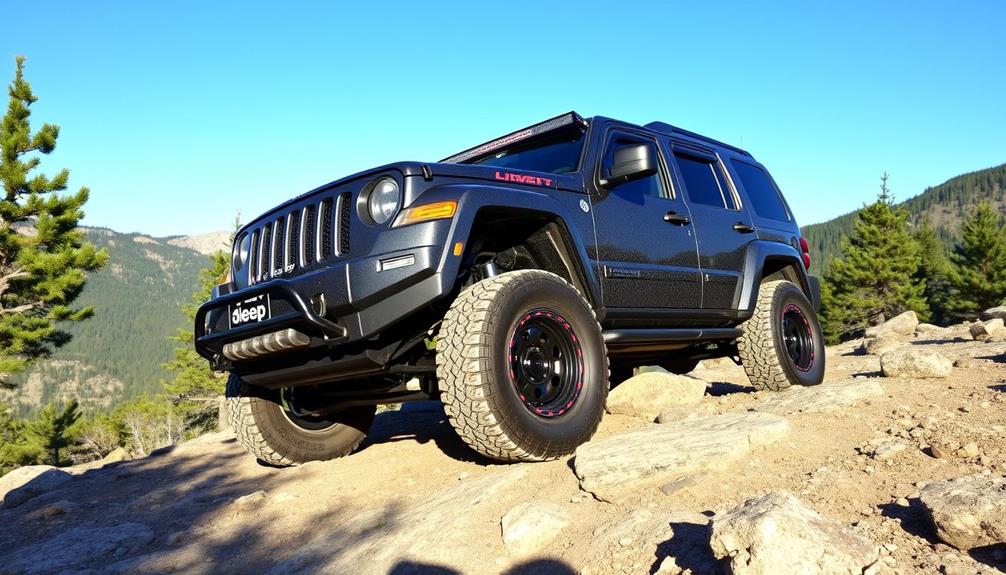
While enhancing the long-term performance of your 2012 Jeep Liberty, a phased approach to upgrades can yield the best results. Start by investing in a cold air intake and a free-flow exhaust system. These upgrades enhance airflow and exhaust efficiency, laying the groundwork for further modifications.
Next, consider a performance programmer, like the Superchips Flashpaq. This tool optimizes engine tuning and allows you to adjust settings for tire size and gear ratios, improving drivability.
Regularly monitor and update your vehicle's tuning through internet updates available for performance programmers. This maintains your Jeep's optimization as you make modifications.
As you plan for more extensive upgrades, like a full forged bottom end or ported race heads, keep the cost-to-benefit ratio and installation complexity in mind.
Engaging with the Jeep community provides valuable insights into long-term performance strategies and troubleshooting. Sharing experiences can help you identify the most effective modifications that align with your performance goals.
Frequently Asked Questions
What Is the Most Common Problem With the 2012 Jeep Liberty?
The most common problem with the 2012 Jeep Liberty is transmission issues. You'll likely experience slipping gears or rough shifting, especially as the mileage increases. Keeping up with maintenance can help mitigate these issues.
How Much Horsepower Does a 2012 Jeep Liberty Have?
Did you know the 2012 Jeep Liberty's 3.7L V6 engine packs 210 horsepower at 5,200 RPM? That's decent power, but you might find it lacks the responsiveness of newer SUVs in its class.
How Is the Ride Quality of a Jeep Liberty?
You'll find the ride quality of the Jeep Liberty quite smooth, with stable handling and a comfortable suspension. It absorbs bumps well, making it suitable for both on-road cruising and off-road adventures.
How Many Miles Does a 2011 Jeep Liberty Last?
A 2011 Jeep Liberty can last between 200,000 miles and 10 years with proper care. Regular maintenance, like oil changes and addressing issues, helps guarantee your vehicle remains reliable and durable throughout its lifespan.
Conclusion
Tuning your 2012 Jeep Liberty is like giving your rugged SUV a new heartbeat, pumping life into every adventure. With the right modifications, you're not just enhancing performance; you're transforming your vehicle into a powerful companion that conquers any terrain. Embrace the journey ahead, knowing your Jeep is ready to tackle challenges with newfound vigor. So, strap in, hit the gas, and let your Liberty roar as it embraces the wild, just like you.
Jimmy is a dedicated drift and drag racing enthusiast who deeply understands the unique tuning requirements for these high-octane sports. His expertise covers everything from drift suspension setups to drag racing launch control systems, providing our readers with the knowledge they need to compete at the highest levels. Jimmy’s passion for these motorsports shines through in his detailed articles and practical recommendations.
Jeep Tuning
Jeep Grand Cherokee 2005 Tuning: Transforming Your SUV Into a Performance Powerhouse
Crafting the ultimate performance upgrade for your 2005 Jeep Grand Cherokee starts here; discover the essential modifications that will elevate your SUV’s capabilities!

Tuning your 2005 Jeep Grand Cherokee is a fantastic way to boost its performance on and off the road. Start by upgrading your air intake and exhaust systems for better airflow and sound. Performance chips can increase horsepower by up to 30%, enhancing torque and fuel efficiency. Don't forget to upgrade the brakes for improved stopping power and install quality shocks for a smoother ride. Adding a lift kit will also enhance off-road capabilities. Each modification helps transform your SUV into a performance powerhouse. Stick around to discover more tips and tricks for optimizing your Grand Cherokee's performance!
Key Takeaways
- Upgrade to performance chips like SCT or Superchips for increased horsepower, torque, and improved fuel efficiency.
- Install a high-performance exhaust system, such as Borla, to enhance engine sound and airflow.
- Enhance handling and ride quality with upgraded shocks and struts like Bilstein 5100 while considering a lift kit for off-road capabilities.
- Regularly maintain the ignition system and air intake to ensure optimal engine performance and responsiveness.
- Pair performance brake upgrades with high-quality tires for improved stopping power and traction during demanding driving conditions.
Vehicle Overview
When considering an SUV that balances practicality with off-road capabilities, the 2005 Jeep Grand Cherokee stands out. This fourth-generation vehicle is designed with a robust structure and a spacious interior, making it ideal for both daily commutes and adventurous getaways.
Its powerful 3.0L diesel engine packs a punch, delivering 240 horsepower that guarantees strong performance, whether you're maneuvering city streets or tackling rugged terrains.
The Jeep Grand Cherokee's design focuses on durability, offering excellent traction and handling across various driving conditions. You'll appreciate its ability to maintain stability while venturing off the beaten path.
However, keep in mind that the emissions system can sometimes be unreliable, leading to potential costly repairs down the line that could impact engine performance.
Despite this, many owners report minimal maintenance costs over a decade, underscoring the reliability and value of the Jeep Grand Cherokee as an adventure-ready SUV.
With this vehicle, you're not just getting a means of transportation; you're investing in a versatile companion for all your journeys. Whether you're hitting the trails or running errands, the Grand Cherokee has you covered.
Essential Maintenance Tips

Regular maintenance is crucial for keeping your 2005 Jeep Grand Cherokee running smoothly and efficiently. To keep your SUV in prime shape, follow these essential tips:
- Change engine oil and filter regularly: Use 5W-20 oil and factory options to maintain peak engine performance and longevity.
- Check and replace spark plugs and wires: Using Taylor shorty wires and Champion plugs can markedly enhance your ignition performance and overall engine efficiency.
- Inspect and maintain your air intake system: Regularly replace air filters and cabin air filters. Consider upgrading to a cold air intake for better airflow, but weigh the pros and cons regarding particle exposure.
Additionally, don't forget to conduct fluid changes for the front/rear axles and the transfer case using factory fluids. This helps prevent costly repairs, including transmission failure.
Cleaning the throttle body can also improve airflow and performance—just skip the throttle body spacers, as they may not deliver benefits.
Performance Modifications

Boosting your 2005 Jeep Grand Cherokee's performance can transform your driving experience, making it more exhilarating and responsive. One of the best ways to achieve this is through performance modifications.
Start by upgrading to a performance chip, like the SCT or Superchips, which can release up to 30% more horsepower and torque while improving fuel efficiency by up to 20%.
Next, consider installing a high-performance exhaust system, such as Borla, to enhance engine sound and airflow, further improving performance.
Pair that with an 85 mm ported throttle body from Modern Muscle for considerable gains in throttle response and acceleration.
To maximize airflow, an AFE Stage 2 cold air intake is a smart investment, providing a boost in horsepower and a deeper engine sound that you'll love.
With these performance modifications, you can notably reduce your 0-60 mph time from around 7 seconds to approximately 6 seconds, making every drive a thrilling experience.
Embrace these upgrades, and you'll feel the difference in performance and responsiveness every time you hit the road.
Upgrading Brakes and Tires

Upgrading your brakes and tires is essential for getting the most out of your Jeep Grand Cherokee.
By selecting performance brake pads and rotors, you'll enhance your stopping power, especially in demanding situations.
Pairing these upgrades with high-quality tires will improve traction and handling, ensuring a safer and more enjoyable ride.
Brake Performance Enhancements
When it comes to enhancing your Jeep Grand Cherokee's brake performance, investing in high-performance brake pads and rotors is a smart move. These upgrades considerably boost stopping power and minimize brake fade, especially during demanding driving conditions.
To maintain peak brake performance, don't forget to regularly replace your brake fluid; it absorbs moisture over time, which can decrease effectiveness.
Here are a few more tips for effective brake performance enhancements:
- Consider installing upgraded shocks and struts, like the Bilstein 5100, to improve ride quality and maintain better tire contact during braking maneuvers.
- Schedule consistent alignment checks and adjustments after any upgrades to guarantee even tire wear and improved handling.
- Pair your brake upgrades with performance-oriented tires for better traction and handling.
Tire Selection and Upgrades
Selecting the right tires for your Jeep Grand Cherokee is vital, especially if you're looking to enhance both performance and safety. Tire selection plays an important role in how your SUV handles various terrains. Upgrading to performance tires like the Firestone Destination 255/70/17 can greatly improve traction and handling, particularly in off-road conditions.
Don't forget about regular inspections of your tire condition and pressure. This practice is important for peak performance and helps prevent uneven wear that can compromise handling and safety.
When choosing tires, you also need to take into account size and load ratings to guarantee compatibility with your Jeep's suspension and load capacity.
Additionally, pairing your new performance tires with high-quality shocks and struts, such as Bilstein 5100, can elevate ride quality and responsiveness during cornering.
Finally, remember that upgrading to performance-oriented brake pads and rotors will enhance braking efficiency, reducing stopping distances and contributing to your overall driving safety.
Suspension Improvements

When it comes to suspension improvements for your Jeep Grand Cherokee, upgrading to quality shocks and struts can greatly enhance ride quality.
Pairing them with a lift not only boosts off-road capability but also improves handling.
Enhanced Ride Quality
Upgrading the suspension on your 2005 Jeep Grand Cherokee can make a world of difference in ride quality and handling. By installing Bilstein 5100 shocks, you'll experience enhanced responsiveness that considerably improves your driving experience on both highways and off-road terrains.
Additionally, a 2-inch lift with Rusty's rear spacers not only elevates your vehicle's stance but also enhances its overall aesthetic.
To further boost your ride quality, consider these key upgrades:
- Regularly evaluate and replace worn suspension components for improved comfort and stability.
- Perform alignment checks after lift installation to guarantee ideal tire wear and handling performance.
- Pair performance-oriented brake pads and rotors with your suspension upgrades for enhanced stopping power.
With these modifications, every drive becomes smoother and more enjoyable, whether you're commuting through city streets or tackling rugged trails.
Investing in your suspension not only enhances responsiveness but also contributes to a safer and more dynamic driving experience.
Improved Off-Road Capability
Off-road adventures call for a vehicle that can handle the toughest terrains, and enhancing your 2005 Jeep Grand Cherokee's suspension is key to achieving that capability. Upgrading to Bilstein 5100 shocks greatly improves ride quality and handling, providing the stability you need on rough terrain while boosting off-road capability.
Consider installing a 2-inch lift kit to increase your ground clearance. This improvement not only elevates your vehicle but also enhances your approach and departure angles, making it easier to navigate obstacles during your adventures.
To complement these shocks, Rusty's rear spacers can create a balanced lift, improving overall suspension performance and responsiveness on challenging surfaces.
Don't forget about regular alignment checks after making these modifications. Maintaining proper alignment guarantees ideal tire wear and handling characteristics, especially with the increased ride height.
The combination of these upgraded suspension components leads to improved articulation, allowing for better traction and control on uneven ground. With these enhancements, your Grand Cherokee will be ready to tackle any off-road challenge you throw its way, transforming your SUV into a true performance powerhouse.
Community Insights
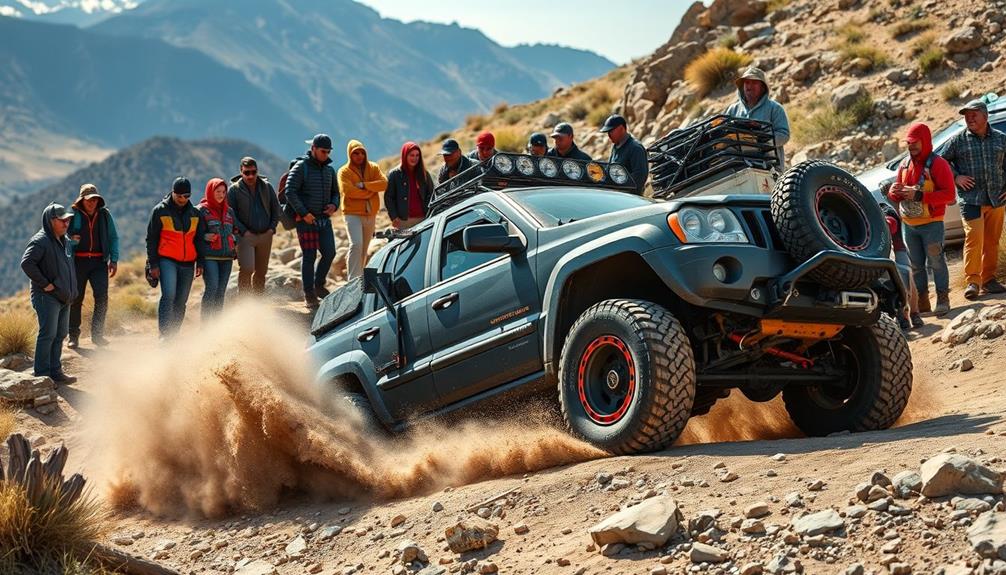
The Jeep community is a treasure trove of insights for anyone looking to tune their 2005 Grand Cherokee. By engaging with fellow enthusiasts, you can uncover valuable tips and shared experiences that can guide your tuning journey. Whether it’s advice on the best aftermarket parts to install or which tuning methods work best for the Jeep Grand Cherokee 2005, the community is a wealth of knowledge. When it comes to jeep grand cherokee 2004 tuning, there are countless resources available online from forums to social media groups where you can connect with other enthusiasts and experts in the field. Gathering information and learning from the experiences of others can help you make informed decisions and avoid common pitfalls in your tuning process.
Many owners rave about their modifications, particularly when it comes to performance chips. SCT performance chips often receive high praise for their reliability and effectiveness.
Here are a few key community insights you should consider:
- Real Experiences: Users frequently share their horsepower gains, helping you gauge the potential benefits of specific modifications.
- Local Recommendations: Enthusiasts often seek advice on trustworthy tuning shops, especially in regions like New England, where community recommendations can lead you to reliable services.
- Collaboration: The focus on optimizing performance through aftermarket parts fosters a collaborative environment, making it easy to learn and share best practices.
Installation Best Practices

Engaging with the Jeep community has likely sparked your enthusiasm for tuning, and now it's time to focus on the installation process. Following installation best practices can make a significant difference in your tuning experience. Make sure to familiarize yourself with the specific requirements and recommendations for your vehicle model, as each Jeep may have slight variations in its tuning needs. For those working on a **Jeep Grand Cherokee 2014 tuning**, paying close attention to software updates and hardware compatibility can ensure optimal performance and reduce the risk of potential issues. Taking the time to properly calibrate and test your setup will lead to a smoother and more rewarding driving experience.
First, verify you have all necessary tools and equipment on hand before starting the installation. This preparation helps streamline the process and avoids delays. Next, follow the detailed installation manuals provided with your performance parts; they often contain essential torque specifications and step-by-step procedures.
It's also important to perform a thorough inspection of your vehicle's existing components. This inspection helps identify any potential issues like worn or damaged parts that could affect the installation.
If you're tackling complex modifications, consider professional installation services. This can save you from damaging expensive components or voiding warranties. Finally, after installation, utilize diagnostic tools to monitor engine performance and confirm all sensors are functioning correctly.
Here's a quick reference table for installation best practices:
| Step | Action | Purpose |
|---|---|---|
| Preparation | Gather tools and equipment | Streamline the process |
| Manual Review | Follow installation manuals | Confirm correct setup |
| Component Inspection | Check existing parts | Identify potential issues |
| Professional Help | Seek expert installation | Avoid costly mistakes |
| Diagnostic Check | Use tools post-installation | Confirm peak performance |
Performance Monitoring Techniques

Monitoring your Jeep Grand Cherokee's performance after tuning is crucial for guaranteeing everything runs smoothly. By implementing effective performance monitoring techniques, you can catch issues before they escalate and maximize your SUV's potential.
Here are some essential practices to help you stay on top of your vehicle's performance:
- Regularly check diagnostic trouble codes (DTC) using an OBD-II scanner to monitor engine performance.
- Track fuel economy and performance metrics with a performance monitoring app to see how tuning modifications affect efficiency.
- Utilize a throttle position sensor (TPS) gauge to assess throttle response and fine-tune adjustments for better acceleration.
Don't forget to conduct periodic inspections of engine components, such as air filters and spark plugs, to maintain peak performance levels.
Additionally, monitor engine temperature and oil pressure with aftermarket gauges to guarantee your vehicle operates within safe parameters, especially after performance upgrades.
Chip Tuning Advantages

After you've implemented effective performance monitoring techniques, exploring chip tuning can take your 2005 Jeep Grand Cherokee to the next level. Chip tuning offers significant advantages that enhance your driving experience. By releasing up to 30% more horsepower and torque, you'll notice a dramatic boost in performance. Plus, with up to a 20% improvement in fuel efficiency, you'll save money on gas during daily commutes.
One of the best parts? Chip tuning typically requires minimal technical knowledge, making it a straightforward plug-and-play solution. Advanced options even provide real-time diagnostics and monitoring, ensuring your engine runs at its best. You can also choose from custom tuning modes—Efficiency, Sport, and Race—to match your specific driving conditions and preferences.
Here's a quick overview of the chip tuning advantages:
| Advantage | Description | Benefit |
|---|---|---|
| Increased Power | Up to 30% more horsepower and torque | Improved acceleration |
| Better Fuel Economy | Up to 20% enhancement in MPG | Cost savings |
| Customization Options | Modes for different driving styles | Tailored performance |
With chip tuning, you're not just enhancing your Jeep; you're transforming it into a performance powerhouse.
Frequently Asked Questions
How Do I Add Horsepower to My Jeep Grand Cherokee?
To add horsepower to your Jeep Grand Cherokee, consider installing a performance chip, upgrading to higher octane fuel, replacing the air intake, adding a performance exhaust, or upgrading the throttle body for better airflow.
How Can I Make My Jeep Grand Cherokee More Fuel Efficient?
Oh sure, who doesn't want to waste more money on fuel? To boost your Jeep's efficiency, try a cold air intake, keep filters fresh, use higher octane, and schedule regular maintenance. Your wallet will thank you!
Can You Tune a Jeep Grand Cherokee?
Yes, you can tune your Jeep Grand Cherokee. By using performance chips or ECU reflashing, you'll enhance horsepower and torque while boosting fuel efficiency. Consider additional modifications like exhaust systems for even better performance.
How Much Horsepower Does a 2005 Jeep Grand Cherokee 5.7 Hemi Have?
You might think the 2005 Jeep Grand Cherokee's power is limited, but its 5.7-liter Hemi V8 engine actually delivers a solid 330 horsepower. That's impressive for an SUV, offering strong performance and capability.
Conclusion
So, you're ready to transform your 2005 Jeep Grand Cherokee into a performance powerhouse, aren't you? With the right modifications, you'll feel the thrill of every twist and turn. Imagine the roar of your upgraded engine, the grip of those new tires, and the confidence of enhanced suspension. But wait—what's the next step? Immerse yourself in the community for insights, keep an eye on performance metrics, and release the beast beneath your SUV's rugged exterior. The adventure's just beginning!
Jimmy is a dedicated drift and drag racing enthusiast who deeply understands the unique tuning requirements for these high-octane sports. His expertise covers everything from drift suspension setups to drag racing launch control systems, providing our readers with the knowledge they need to compete at the highest levels. Jimmy’s passion for these motorsports shines through in his detailed articles and practical recommendations.
Jeep Tuning
Jeep Grand Cherokee 2006 Tuning: Unlocking the Full Potential of Your Luxury SUV
Unlock the hidden power of your 2006 Jeep Grand Cherokee through tuning, and discover the transformative techniques that await you.
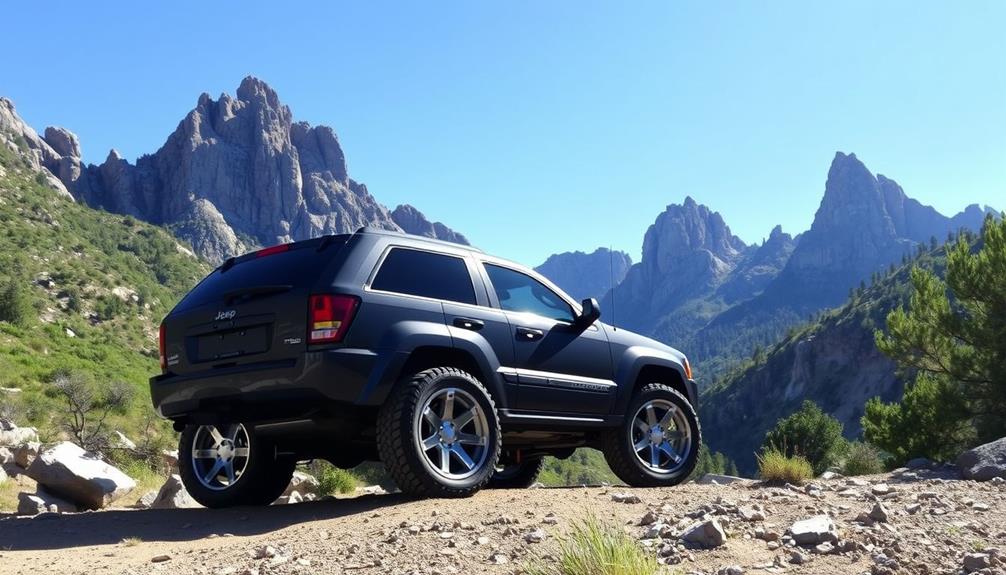
Tuning your 2006 Jeep Grand Cherokee is a game changer, allowing you to access its full potential. By optimizing the ECU, you'll see improved throttle response and increased horsepower, making your driving experience more engaging. Techniques like disabling EGR and removing DPF can vastly enhance efficiency and performance while extending the lifespan of key components. Plus, specialized tuners provide effective programming options tailored to your specific model. Enjoy better fuel economy and responsive handling, giving you confidence on any terrain. Discover what it takes to elevate your luxury SUV's capabilities and how to get started.
Key Takeaways
- ECU tuning optimizes performance, enhancing throttle response and increasing power beyond factory ratings, offering up to 240 hp gains.
- Disabling EGR and removing DPF can significantly improve engine efficiency and acceleration for a more engaging driving experience.
- Specialized tuners like Superchips and Hypertech provide tailored programs to enhance power and fuel economy for various engine configurations.
- User feedback highlights notable horsepower boosts and improved fuel efficiency, making tuning accessible for DIY enthusiasts.
- Safety measures include a 2-year engine warranty and a 50-day trial period to evaluate performance improvements post-tuning.
Overview of the Jeep Grand Cherokee
The Jeep Grand Cherokee's legacy spans decades, having been in production since 1983 and now reaching its fourth generation. This SUV combines family car practicality with impressive off-road capabilities, making it a versatile choice for many drivers.
The 2006 Grand Cherokee comes with various engine options, including a base 3.7L V6 with 210 horsepower and a powerful 6.1L V8 producing 420 horsepower.
While the interior boasts quality features like heated leather seats and modern audio systems, ensuring comfort and luxury during your travels, you should also be aware of its fuel consumption. With the right ECU settings, you can enhance performance and potentially improve efficiency, although the 2006 model has received poor reliability ratings, which might affect your ownership experience.
The Grand Cherokee typically has an average lifespan of around 200,000 miles, and its price range in the used market varies from $5,108 to $17,318.
Keep in mind that high maintenance costs and common wiring issues can impact satisfaction levels. Overall, the Jeep Grand Cherokee remains a solid option for those seeking a blend of style, performance, and utility.
Understanding ECU Tuning

Understanding ECU tuning starts with recognizing how an ECU reflash can greatly enhance your Jeep's performance.
By optimizing parameters like power and torque, you can experience improved throttle response and towing capacity.
Let's explore the techniques that can take your driving experience to the next level.
ECU Reflash Benefits
Improved performance and efficiency are just a few benefits you can gain from ECU tuning your 2006 Jeep Grand Cherokee. By reflashing the engine control unit with specialized software, you can release more power and torque, surpassing the factory rating of 240 horsepower.
This enhancement not only improves your SUV's towing capacity but also sharpens throttle response, giving you peace of mind when maneuvering during overtaking, even in challenging weather conditions.
Fuel efficiency is another significant advantage; you could save up to 1.5 liters per 100 kilometers, leading to impressive cost savings over time.
Additionally, ECU tuning addresses common emissions issues associated with the 3.0L diesel engine, boosting overall reliability and reducing the chances of costly repairs down the road.
Performance Optimization Techniques
Many owners of the 2006 Jeep Grand Cherokee seek performance optimization techniques to release their vehicle's full potential.
One of the most effective methods is ECU tuning, which can markedly enhance engine performance by boosting power and torque. You'll notice improvements in throttle response and towing capacity, making your SUV even more capable.
When considering ECU tuning, here are some common techniques to explore:
- Disable Exhaust Gas Recirculation (EGR): This can improve engine efficiency and reduce maintenance costs.
- Remove Diesel Particulate Filters (DPF): By eliminating these filters, you can enhance overall engine performance.
- Manage Diagnostic Trouble Codes (DTC): Tuning solutions can address and eliminate these codes, ensuring a smoother driving experience.
Specialized tools like the Alientech KESS3 allow tuners to reflash your engine's control unit, optimizing fuel consumption while addressing factory emissions issues.
Experienced tuners understand the factory hardware limitations and can deliver notable power increases without sacrificing reliability.
Advantages of Increased Power
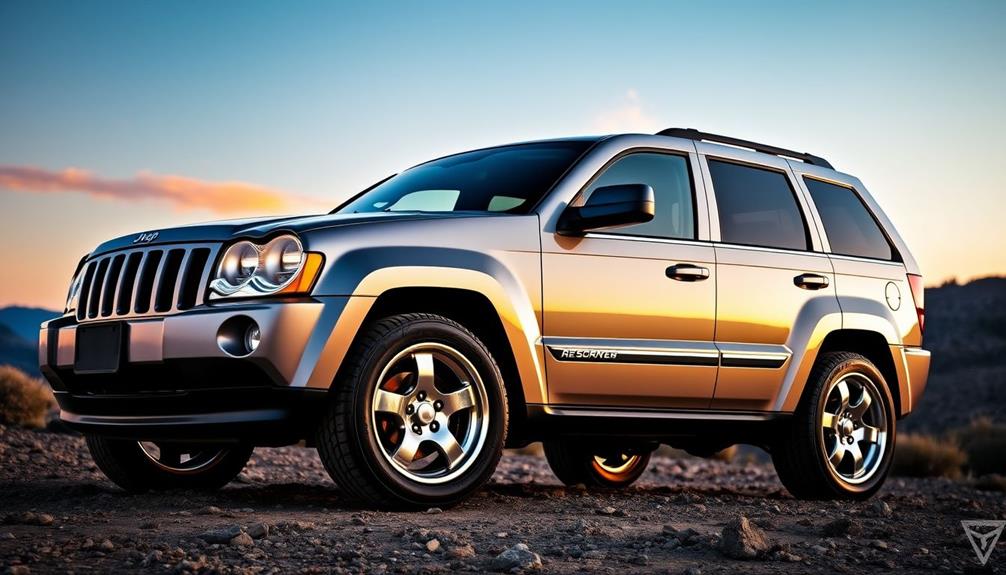
When you tune your 2006 Jeep Grand Cherokee, you'll notice a marked improvement in throttle response, making your driving experience more responsive and engaging.
This enhanced efficiency not only boosts your confidence during overtaking maneuvers but also contributes to greater overall safety on the highway.
With increased power, you can tackle various driving situations with ease, knowing your vehicle is ready to perform.
Enhanced Overtaking Maneuver Safety
Tuning your 2006 Jeep Grand Cherokee can greatly enhance safety during overtaking maneuvers, as increased power and torque allow for quicker acceleration.
With a factory rating of 240 horsepower, the 3.0L diesel engine can achieve substantial improvements through ECU tuning. This means you can confidently steer on highways and make those critical lane changes with ease.
Here are a few advantages of enhanced power for overtaking:
- Quicker Acceleration: You'll notice a significant boost in your vehicle's responsiveness, allowing you to merge safely into traffic.
- Smoother Driving Experience: Tuning provides a more seamless shift during lane changes, reducing the stress of steering through busy roads.
- Improved Reliability: Tuned engines often experience fewer emissions system issues, ensuring you won't face unexpected repairs that could compromise safety.
Improved Throttle Response Efficiency
An enhanced throttle response can transform your driving experience in the 2006 Jeep Grand Cherokee, providing you with quicker acceleration and more immediate power delivery. Tuning your vehicle optimizes the 3.0L diesel engine, allowing you to enjoy a more engaging ride, especially on open roads. You'll notice that overtaking slower vehicles becomes a breeze, with improved safety and confidence behind the wheel.
Here's a quick comparison of the advantages of improved throttle response:
| Feature | Benefit |
|---|---|
| Quicker Acceleration | Faster response to your inputs |
| Improved Safety | Easier overtaking |
| Enhanced Driving Experience | More engaging and fun rides |
| Optimized Engine Reliability | Fewer emissions system issues |
| Tailored ECU Solutions | Works within factory limits |
Emissions Solutions for Performance
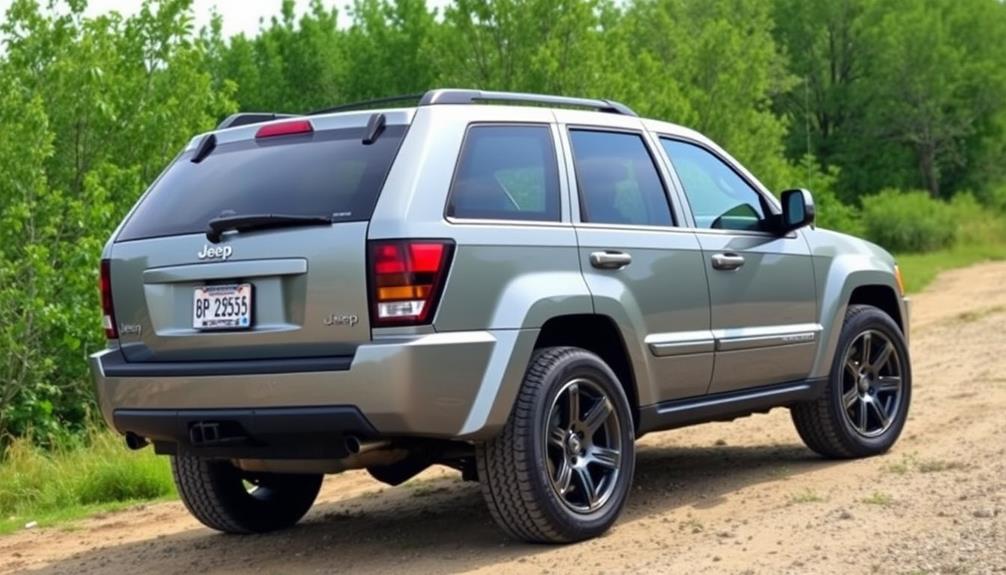
Although emissions systems are essential for compliance, they can also hinder your Jeep Grand Cherokee's performance. By taking a closer look at emissions solutions, you can reveal a more powerful driving experience.
Disabling the Exhaust Gas Recirculation (EGR) system reduces engine stress and enhances throttle response. Removing the Diesel Particulate Filter (DPF) allows for increased exhaust flow, leading to better acceleration and overall engine efficiency.
Consider these emissions solutions for performance enhancement:
- EGR Disabling: Improves throttle response and reduces engine strain.
- DPF Removal: Increases exhaust flow for enhanced acceleration.
- SCR Adjustments: Optimizes emissions control while boosting power.
Additionally, managing Diagnostic Trouble Codes (DTC) through tuning minimizes false alarms, increasing engine reliability and reducing costly repairs.
Implementing these emissions solutions not only enhances your Jeep's performance but also extends the lifespan of key components, making your vehicle more robust.
Customer Engagement Opportunities

Engaging customers effectively can greatly elevate their experience with your Jeep Grand Cherokee tuning services. By offering specialized tuning options, you not only enhance vehicle performance but also boost customer satisfaction.
When you become a dealer for tuning solutions, you diversify your product offerings, attracting new customers enthusiastic to reveal their SUV's full capabilities.
Personalized tuning options create tailored solutions that resonate with individual preferences and driving styles. This approach makes customers feel valued and understood, fostering a lasting connection with your brand.
Providing extensive documentation and support throughout the tuning process further builds trust, ensuring a seamless experience that encourages repeat business.
Encouraging customer feedback is essential. By actively seeking their insights, you foster a community around your tuning services, leading to valuable information that can drive improvements.
This engagement helps you stay ahead of customer needs and preferences, solidifying your reputation as a go-to source for Jeep Grand Cherokee tuning.
Key Models for Tuning
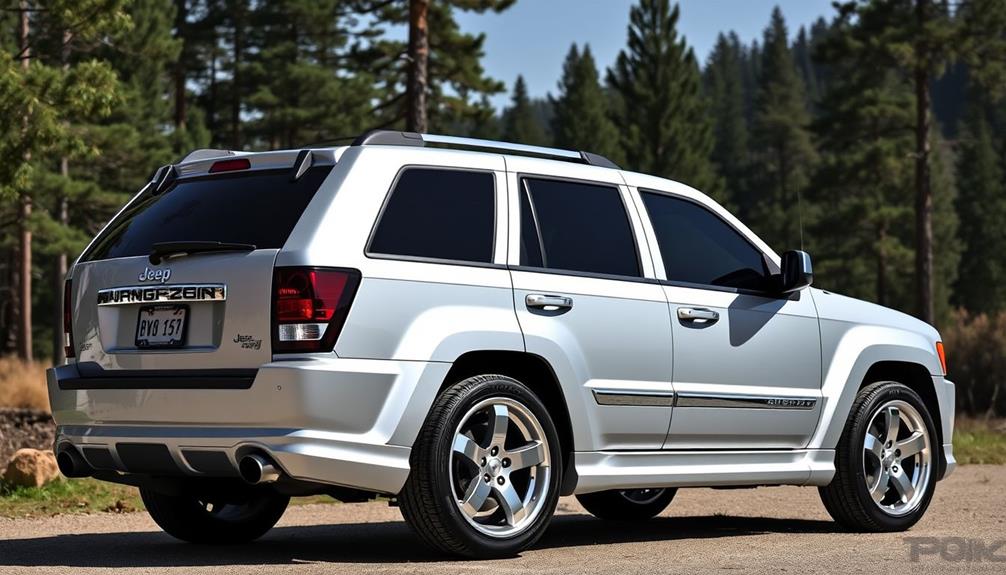
When considering tuning options for the 2006 Jeep Grand Cherokee, you'll find several key models that cater to different performance needs and preferences.
Each model offers unique engine configurations and tuning potential, making it vital to choose one that aligns with your goals.
- Laredo 4dr 4×4: Equipped with a 3.7L V-6 engine, this model provides a solid foundation for light tuning and efficiency improvements.
- Limited 4dr 4×2 / 4dr 4×4: With a 4.7L or 5.7L V-8 engine, the Limited models present a balance of power and versatility, making them suitable for moderate performance enhancements.
- SRT8 4dr 4×4: The powerhouse of the lineup, featuring a 6.1L V-8 engine that delivers a staggering 420 hp, ideal for serious performance tuning.
Understanding your specific engine configuration is essential for effective tuning.
Popular options like Superchips and Hypertech can help maximize power and efficiency, but knowing which model you have guarantees you select the right modifications for the best results.
Each model's tuning potential opens up exciting possibilities for enhancing your Grand Cherokee's performance.
Performance Enhancements and Products

Numerous performance enhancements and products can elevate your 2006 Jeep Grand Cherokee's capabilities, transforming it into a more powerful and responsive vehicle. Tuning options like Superchips and Hypertech are excellent choices. For instance, Superchips offers a 91 octane program that boosts power and improves fuel economy. Alternatively, the Hypertech Max Energy 52501 tuner is specifically designed for your model, providing effective performance improvements.
To maximize the benefits of these tuners, consider combining them with modifications such as enhanced exhaust and intake systems. These upgrades address factory limitations and can lead to remarkable performance gains. Exploring various programming options can also help you achieve better fuel efficiency while enjoying increased power output.
Here's a quick reference table for performance enhancements:
| Tuner/Product | Benefits |
|---|---|
| Superchips | 91 octane program, power & fuel economy |
| Hypertech Max Energy | Effective performance improvements |
| Exhaust & Intake Mods | Remarkable performance gains |
Engage with community forums to tap into a wealth of knowledge and insights on tuning and modifications for your Jeep. You'll find valuable discussions that can guide your upgrade journey.
User Experiences and Feedback

Tuning your 2006 Jeep Grand Cherokee can lead to transformative experiences, with many owners reporting significant boosts in engine performance.
Many have experienced noticeable increases in horsepower and torque, especially when using tuners like Superchips and Hypertech. You'll likely appreciate the improved fuel economy, with some users saving up to 1.5 liters per 100 kilometers after making modifications.
As you immerse yourself in the tuning world, keep in mind the importance of understanding your existing modifications. Factors like exhaust and intake upgrades can greatly impact your performance results.
Here are some common user experiences:
- Ease of Installation: Many owners praise the straightforward installation process, making it accessible for DIY enthusiasts.
- Customization Options: Tuners offer tailored adjustments based on individual driving preferences, enhancing your driving experience.
- Community Support: Forum discussions reveal a strong network of Jeep Grand Cherokee owners, sharing experiences and recommendations that aid informed decision-making.
Safety and Warranty Considerations

Safety and peace of mind are critical when considering modifications to your 2006 Jeep Grand Cherokee. With thorough safety guarantees, tuning services offer a 2-year engine warranty, making sure you feel secure after making enhancements. You'll also benefit from a 50-day trial period, giving you a chance to evaluate performance improvements and adjust settings as needed.
The tuning process includes advanced performance control features, providing five unique driving modes tailored to various driving conditions and personal preferences. This versatility enhances your driving experience while maintaining safety.
Moreover, tuning services effectively manage emissions-related modifications, addressing any Diagnostic Trouble Codes (DTC) to keep your vehicle compliant and reliable. Throughout this journey, customer support is available to guide you, making certain safe and effective modifications.
| Warranty & Safety Features | Description |
|---|---|
| 2-Year Engine Warranty | Thorough coverage post-modification |
| 50-Day Trial Period | Evaluate performance improvements |
| Five Driving Modes | Customize driving experience for safety and ease |
| Emissions Compliance Management | Make certain reliability and adherence to regulations |
Frequently Asked Questions
Can You Tune a Jeep Grand Cherokee?
Yes, you can tune a Jeep Grand Cherokee to enhance performance. Utilizing specialized ECU tuning solutions, you'll release more horsepower and improve fuel efficiency, making your driving experience more enjoyable and responsive. Just verify compatibility first.
What Is the Most Luxurious Jeep Grand Cherokee?
The most luxurious Jeep Grand Cherokee is the Overland model. It combines premium features, a powerful 5.7L V-8 engine, and high-quality interior materials, ensuring you enjoy a comfortable and upscale driving experience every time.
How Many Miles Do 2006 Grand Cherokees Usually Last Until?
On average, a 2006 Jeep Grand Cherokee can last about 200,000 miles with proper maintenance. However, reliability issues may arise around 75,000 miles, so staying proactive with service can help extend its lifespan.
What Are the Most Common Problems With the 2006 Jeep Grand Cherokee?
The most common problems with the 2006 Jeep Grand Cherokee include electrical failures, engine issues around 75,000 miles, and transmission troubles at 105,000 miles. You'll often face high maintenance costs due to these concerns.
Conclusion
In summary, tuning your 2006 Jeep Grand Cherokee can truly unleash a world of performance, turning your luxury SUV into a powerhouse. Just like upgrading from a flip phone to a smartphone, the enhancements you'll experience are game-changing. You'll enjoy increased power, improved efficiency, and a more engaging driving experience. So, roll up your sleeves, explore the tuning options, and take your Grand Cherokee to a whole new level—your adventure awaits!
Jimmy is a dedicated drift and drag racing enthusiast who deeply understands the unique tuning requirements for these high-octane sports. His expertise covers everything from drift suspension setups to drag racing launch control systems, providing our readers with the knowledge they need to compete at the highest levels. Jimmy’s passion for these motorsports shines through in his detailed articles and practical recommendations.
-

 Tesla Tuning2 months ago
Tesla Tuning2 months agoTesla Cybertruck Sales: How Many Have Been Sold So Far?
-

 Tesla Tuning2 months ago
Tesla Tuning2 months agoTesla Battery Replacement Costs Revealed: How Much Will You Pay?
-

 Tesla Tuning2 months ago
Tesla Tuning2 months agoWhere Are Tesla Cars Made? Explore the Manufacturing Locations!
-

 Tesla Tuning2 months ago
Tesla Tuning2 months agoSupercharging Tesla: How Long Does It Really Take?
-

 Tesla Tuning3 months ago
Tesla Tuning3 months agoTesla Mileage: How Many Miles Can You Drive on a Full Charge?
-

 Tesla Tuning2 months ago
Tesla Tuning2 months agoHow Much Does It Cost to Lease a Tesla? Get the Full Breakdown!
-

 Tesla Tuning3 months ago
Tesla Tuning3 months agoTesla CarPlay: Does Tesla Have Apple Integration?
-

 BMW Tuning3 months ago
BMW Tuning3 months agoBMW B58 Tuning: Maximize Power in BMW’s Powerful Six-Cylinder Engine




















